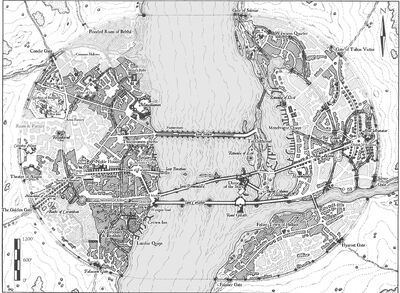Osgiliath is the largest city in Gondor, and the main source of food for the entire Kingdom, as the southwest section of the city houses the only farms left in Gondor. It is really the only city in Gondor other then Minus Tirith to be in a serviceable position. In this position it has gained a massive amount of influence in Gondor, and over the period following the Civil War Osgiliath is the source of a growing majority of the leadership in Gondor. This change has led to some eye raising in Minus Tirith where the nobles do not like to share, but the population of Osgiliath makes it impossible to ignore.
Osgiliath is the single largest consentration of Atlantians in Gondor with a population that is so large that there is barely a citizen in Gondor that can't tie their heritage back to Osgiliath at some point. The population here are very similar to the way the Atlantians are in most other places, but much like Minas Tirith and the western cities of Gondor the people of Osgiliath are somewhat more civilized and refined then the southern settlements, or the more fortified western cities.
Osgiliath is ruled over by the two princely houses in the form of House Eliendal, and House Vonedell of which House Eliendal controls the western bank of the city of Osgiliath making themselves the more wealthy of the two princely houses, while House Vonedell controls the eastern bank of the city of Osgiliath and controls more military might but is weaker economically.
Unlike Gondor's other cities, Osgiliath possesses no rural hinterland of its own. Its walls straddle the boundaries of the wards of Anórien and Ithilien in the midst of the Anduin vale. The two halves of the city rise gently from the eastern and western banks of the Great River. Here, at its narrowest point, the Anduin ranges between twenty-nine and thirty-six hundred feet in width. Four large bridges (one of them ruined) span the breadth of the river. They reach the city by way of small islet near to the eastern bank. Although Osgiliath accommodates a moderately deep harbour, the Anduin is generally quite shallow as it passes through the city. It depth ranges from between fifteen to thirty-five feet. Most times, especially when the river is low, vessels possessed of a deep draft simply weigh anchor in Pelargir.
Osgiliath was constructed by the Numenorian brothers Isildur, and Anarion of whom brought their powerful House Eliendal to the site and grew it on their own. At first it hugged the western side of the river, but Isildur would construct a mighty bridge which allowed eastern Gondor, and western Gondor to be connected, and through these bridges flowed the trade from west to east, and back again making the city fabulously rich. During the Umbar Civil War the city was heavily increased in size, and walls were added to it to make sure that it was properly defended. Following this Osgiliath was basically the only city that was operational following the Gondor Civil War which destroyed much of eastern Gondor and left Osgiliath as the last stand position for the Gondor defenders.
Layout[]

Unlike Gondor's other cities, Osgiliath possesses no rural hinterland of its own. Its walls straddle the boundaries of the wards of Anórien and Ithilien in the midst of the Anduin vale. The two halves of the city rise gently from the eastern and western banks of the Great River. Here, at its narrowest point, the Anduin ranges between twenty-nine and thirty-six hundred feet in width. Four large bridges (one of them ruined) span the breadth of the river. They reach the city by way of small islet near to the eastern bank.
Although Osgiliath accommodates a moderately deep harbour, the Anduin is generally quite shallow as it passes through the city. It depth ranges from between fifteen to thirty-five feet. Most times, especially when the river is low, vessels possessed of a deep draft simply weigh anchor in Pelargir.
Osgiliath is in truth two cities, each of which sprawls out along its own bank of the river. Both halves of the city cluster around the gates ofthe Great Bridge and, in each quarter, all the city's streets extend outward from this focal point. While not designed to whitstand a siege, it was nonetheless walled during
History[]
Early History[]
The first bridge over Great Anduin was built shortly after the location was selected for new settlement by the incoming Numenorians. Isildur and his kinsmen built their homes on the eastern banks of Anduin while Anárion occupied the western shore. Their thrones sat side by side in the Great Hall of the Stars (Rond Giliath) at Tol Gilthoniel. During the Civil War of Umbar the forces of the Empire of Numeron centered their defences around Osgiliath and it was during this time that much of the construction was completed in the city, and when the second teir of the walls was finished. The first bridge was torched down during this conflict, but it was soon replaced by even greater timber bridge. Isildur's original construction was later surpassed by Anárion's youngest son Meneldil, who claimed the throne of Gondor after Isildur's death. He built a majestic vaulted stone bridge over Anduin during the waning years of the Empire of Numeron and dedicated it to his grandson Eärendil, who was born during the Downfall of Numeron.
Founding under Gondor[]
When Gondor's fortunes grew as it became a Kingdom of its own following the Downfall of Numeron, Osgiliath became bureaucratic and ceremonial capital of a great sea-going empire. It's population quadrupled, and it was adorned by myriad of majestic buildings both public and private. Osgiliath was known both for its size and spectacular beauty, and thus it became the capital of Gondor in everything but ceremony due to the fact that the White Tree of Gondor was in Minas Tirith.
Growth[]
The unfortunate part of the growth of Osgiliath was that it only begin during the collapse of the eastern half of Gondor during the early wars against Mordor. Before this time the region to the east of Osgiliath had been covered with farms, and small towns and villages but with the capture of Minus Morgal the east was nearly wide open to assault. Over the years following the collapse of Minus Morgal the regions east of Osgiliath became under constant assault and this led to large scale death, but also to large scale emmigration westward.
This migration brought huge population increases to the city itself which expanded nearly 150% over the course of less then ten years. This kind of expansion led to large slums being constructed outside of the walls of the western coast.
Points of Interest[]
The Bridge of Osgiliath[]
The Bridges
Iant Breithon (2nd century T.A.), formerly known as Iant Eärendil or Iant Iaur. Collapsed in 1303, lies in ruin.
Iant Anardil (4th century T.A.), connecting Dome of the Stars to Tol Gilthoniel. Repaired many times.
Iant Sollen (8th century T.A.), also known as Iant Siriondil. The Closed Bridge connects Thoronumen to Tol Gilthoniel and further to Wilwarin heptonard via Iant Formenel.
Iant Ciryaher (11th century T.A.), replaced timber bridge originally built during Isildur's reign. The Great Bridge.
Iant Romendacil (13th century T.A.), connecting the Bull Market to the Dome of the Stars.

